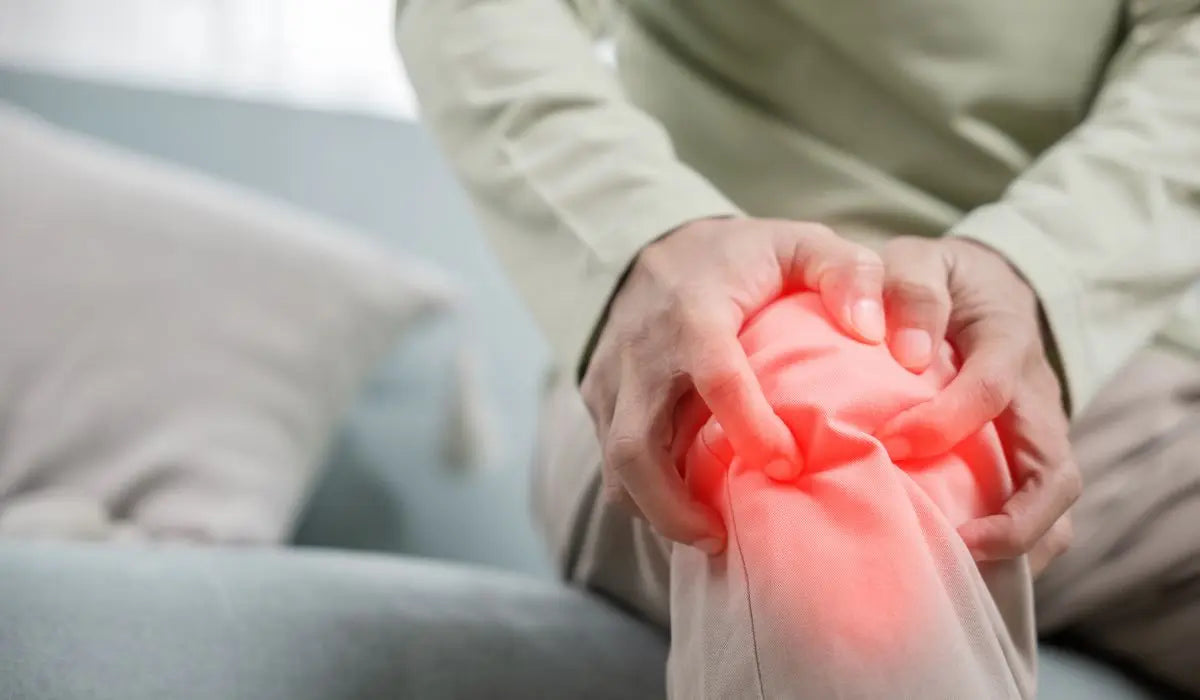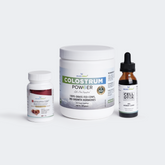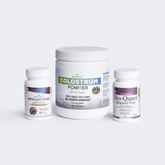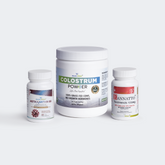Estimated Reading Time: 7 minutes
|Astaxanthin and joint pain relief have long been linked together in terms of natural health solutions. This powerful antioxidant, best known for its vibrant red hue, has proven invaluable in alleviating various types of joint discomfort. Due to its potent anti-inflammatory properties, Astaxanthin offers an attractive option for managing discomfort naturally.
This blog highlights how this groundbreaking compound can address joint pain - from acute knee and back discomfort to complex conditions such as arthritis.
First Things First: What is Astaxanthin?
Astaxanthin, a carotenoid found naturally in certain algae and seafood, provides pink-red hues in salmon, shrimp, and lobster. What sets Astaxanthin apart is its exceptional antioxidant properties, which outshone many other antioxidants. This quality makes Astaxanthin particularly helpful in combating joint inflammation and pain by decreasing oxidative stress levels.
Astaxanthin and Its Role in Joint Health
Astaxanthin, a naturally occurring carotenoid, has become an invaluable ally in joint and muscle wellness. Its benefits extend beyond basic pain relief; in this section, we explore the connection between Astaxanthin and Joint Pain Relief.
1. Comprehensive Pain Management
Astaxanthin stands out among other pain management treatments for its impressive effectiveness in comprehensive pain relief. While traditional painkillers only provide temporary relief, Astaxanthin goes beyond this approach by targeting the source of discomfort - inflammation.
By inhibiting its processes, Astaxanthin provides a holistic way of relieving joint discomfort - something especially beneficial in managing long-term conditions like osteoarthritis, where long-term care management is a must.
2. Targeting Joint Inflammation
Inflammation is among the primary sources of joint pain and stiffness, making Astaxanthin an excellent anti-inflammatory choice to address it. It blocks certain chemicals and pathways within the body, leading to inflammation.
Thus, it decreases swelling and discomfort in affected joints - something especially helpful in cases like rheumatoid arthritis, where inflammation plays a significant role.
3. Enhancing Cartilage Health
Astaxanthin plays an integral part in protecting cartilage health. By decreasing oxidative stress - one factor contributing to cartilage degradation - Astaxanthin helps preserve its integrity, which in turn can halt joint diseases like osteoarthritis that involve wearing and tear.
4. Supporting Muscle Function
Astaxanthin provides significant support to muscle health. It reduces muscle damage and inflammation post-exercise, leading to faster recovery and less soreness post-workout.
This attribute is especially advantageous for active individuals or athletes who regularly experience muscle strain or fatigue.
5. Promoting Overall Joint Mobility
Regular consumption of Astaxanthin has been associated with improved joint mobility by decreasing pain and inflammation and supporting muscle and joint health.
Also, Astaxanthin for joint pain relief provides essential benefits in maintaining a range of motion for active lifestyles, particularly among senior citizens susceptible to joint issues.
6. Astaxanthin in Autoimmune Joint Conditions
Astaxanthin has shown promise for managing autoimmune joint conditions like rheumatoid arthritis by modulating immune response and decreasing inflammation.
By acting as an adjunct therapy alongside traditional treatments, Astaxanthin could offer effective management.
7. Astaxanthin and Preventive Joint Care
Prevention is key to joint health, and Astaxanthin's antioxidant properties play a vital role. By neutralizing free radicals that could damage joint tissues, Astaxanthin could prevent future joint problems by protecting against further oxidation damage.
Astaxanthin and Traditional Supplements: A Comparative Insight
Astaxanthin stands out in the supplement world, especially when compared with more established joint health options such as glucosamine and chondroitin.
In this section, we explore why Astaxanthin for joint pain relief would be the right pick for some individuals.
1. Astaxanthin Is Promising as an Antioxidant Acteur
One of the key advantages of Astaxanthin lies in its powerful antioxidant capabilities, which surpass what glucosamine and chondroitin provide. This compound's ability to neutralize free radicals and combat oxidative stress provides broad health benefits beyond joint health alone.
Astaxanthin's unique abilities offer holistic solutions to address chronic inflammation often associated with joint disorders for greater joint well-being.
2. Astaxanthin for Arthritis Offers Rapid Inflammation
Glucosamine and chondroitin have become well-known supplements for maintaining joint cartilage health and soothing mild pain relief.
Astaxanthin's powerful anti-inflammatory properties make it an excellent way to address inflammation as the source of joint discomfort in conditions like arthritis.
Astaxanthin for arthritis directly combats the inflammation at its source and it offers quicker and more lasting relief than ever.
3. Enhancing Joint Mobility and Flexibility
One unique characteristic of Astaxanthin is its effect on joint mobility and flexibility. While other supplements focus solely on slowing joint degradation, Astaxanthin may actively enhance it - this improvement is especially beneficial to individuals experiencing stiffness and limited mobility due to joint pain.
4. Safety and Tolerability
Astaxanthin boasts an outstanding record regarding safety and tolerability, with minimal reported side effects from users of other joint supplements like glucosamine or chondroitin.
Furthermore, Astaxanthin may even be beneficial for individuals sensitive to other supplements.
5. Synergistic Effects with Other Supplements
Astaxanthin can be taken in tandem with traditional supplements like glucosamine and chondroitin for maximum effect, providing joint protection while enjoying the anti-inflammatory and antioxidant effects of Astaxanthin at the same time.
This combination enables individuals to reap the joint-protecting effects of the former while taking advantage of Astaxanthin's anti-inflammatory and antioxidant benefits.
Recommended Astaxanthin Dosage for Joint Pain Relief
Establishing the best Astaxanthin dosage for joint pain to provide effective joint pain relief is paramount. While individual needs may differ, general guidelines will ensure efficient and safe usage.
Starting Dosage
For those new to Astaxanthin supplements, starting slowly is recommended. A starting dose of 4 mg may give your body time to adapt and identify any possible sensitivities or adverse reactions.
Gradual Increase
If the initial Astaxanthin dosage for joint pain proves well-tolerated and no significant improvements in joint pain can be seen, an incremental increase of up to 12 mg daily could provide greater benefits while remaining safe.
It's best to make these adjustments over several weeks for best results.
Consulting Healthcare Professionals
Consultation with healthcare professionals before increasing dosage or having any concerns is paramount for optimal joint pain treatment and management.
Their advice can be tailored specifically to you based on individual health conditions, current medications, and specific joint pain concerns.
Long-Term Usage
Astaxanthin can generally be taken safely for long-term use, although regular assessments with healthcare professionals are advisable to assess its efficacy and any possible side effects.
Regular check-ins with them will help establish what duration best meets individual needs.
Monitor Effectiveness
A journal to track changes in joint pain severity and mobility is an invaluable way of measuring the efficacy of any chosen dose, providing information for potential adjustments with healthcare providers.
Astaxanthin as a Natural Solution for Tendonitis
Tendonitis can seriously affect daily activities and quality of life, leading to inflammation and pain in tendons that significantly interferes with daily tasks and overall quality of life.
Although conventional treatments exist for tendonitis, many individuals seek natural relief and healing through Astaxanthin for Tendonitis. It is an antioxidant with proven health benefits - a solution that many find attractive.
Understanding Tendonitis and Its Impact
Tendonitis occurs when tendons, the thick cords that connect muscles to bones, become inflamed or irritated. This condition typically impacts shoulders, elbows, wrists, knees, and heels and causes pain and restricted movement.
Also, repetitive movements or sudden injuries often trigger tendonitis, which makes it common among athletes, office workers, and the elderly alike.
Astaxanthin for Tendonitis
Due to its anti-inflammatory properties, Astaxanthin for Tendonitis provides the ideal remedy.
By decreasing inflammation and relieving pain associated with tendon damage, Astaxanthin helps speed healing time while combating oxidative stress, contributing to tendon damage. All this assists the healing process.[1]
The Antioxidant Advantage
As an antioxidant, Astaxanthin neutralizes free radicals in the body to protect tissues and tendons against further injury from oxidative stress-related injuries and wear and tear.
Furthermore, its improved blood flow ensures essential nutrients and oxygen reach areas inflamed by inflammation for healing purposes, speeding recovery time.
Integrating Astaxanthin into Tendonitis Management
Integrating Astaxanthin into your tendonitis management plan may supplement physical and traditional treatments. Due to its intrinsic origin and lack of significant side effects, Astaxanthin should be safe for most individuals.
However, for optimal results, please seek advice from healthcare professionals regarding Astaxanthin dosage for joint pain and potential interactions between medications.
Conclusion
Overall, Astaxanthin offers an effective natural solution for joint pain relief, providing hope to those dealing with arthritis, muscle soreness, or other discomfort related to their joints. This blog has defined the connection between Astaxanthin and Joint Pain Relief in the right manner.
With remarkable antioxidant and anti-inflammatory properties that alleviate discomfort and promote overall joint health and mobility, adopting Astaxanthin could be your path toward living an active, pain-free life!
As you consider adding this powerful supplement into your routine today, remember it all starts with one conscious decision towards improved joint health; don't delay starting your journey with Astaxanthin today for an easier tomorrow!
Disclaimer: These statements have not been assessed by the FDA. The information contained within this page is for educational purposes only. It is not intended to replace the advice or attention of health care professionals.
References




































